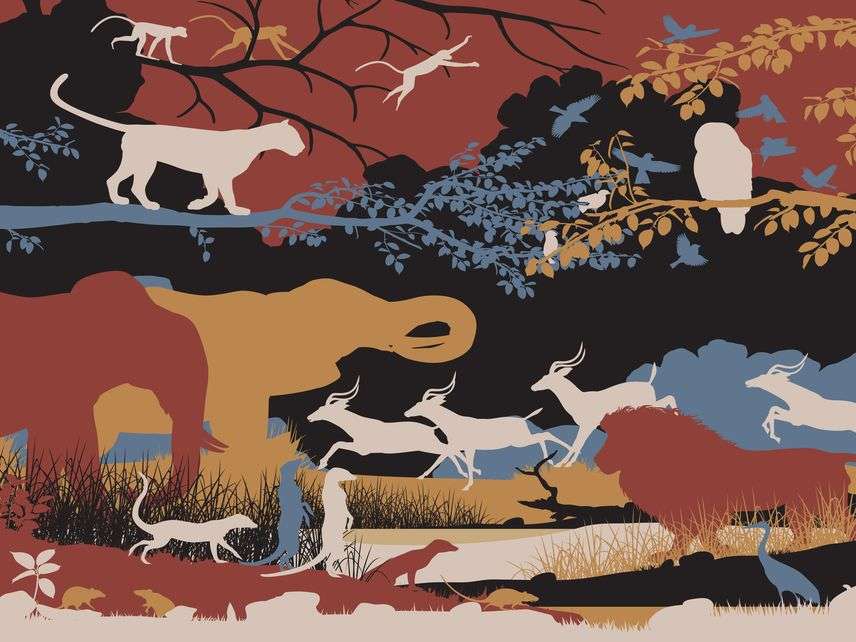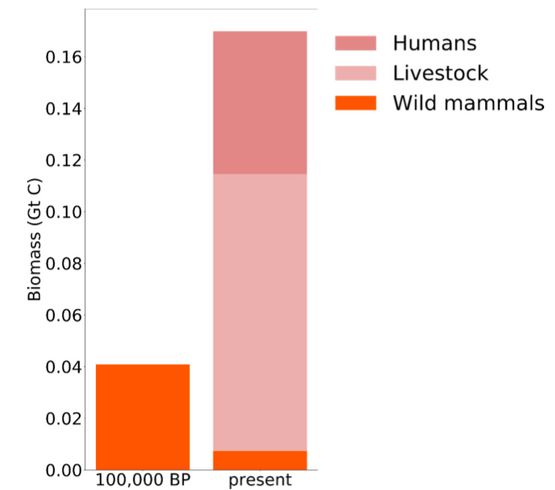Wild Animal Populations Down 60 Percent Since 1970
But economic growth will reverse this trend by sparing lots more land for nature during this century.

Twenty-six million elephants roamed Africa before 1500, according to one estimate. That dropped to around 10 million just before the outbreak of the First World War and now stands at around 350,000 today. Some 200,000 wild lions hunted in Africa a century ago; now only 20,000 do. Between 30-50 million guanacos grazed the South American Pampas before the arrival of Columbus; now 2 million or so do.
In North America, 30 to 60 million bison used to ranged from the Appalachians to the Rockies, from the Gulf Coast to Alaska. By 1889, there were just 1,091 left. Today, the private and public herds number about 500,000 bison. Before 1500, North America was home to 60 to 400 million beavers; today 10 to 15 million live in the wild.
In 1900, India was home to 20,000 to 40,000 wild tigers. That number had fallen to just over 1,400 by 2006, but has since risen to more than 2,200 in 2014, when the last census was done. In 1800, about 1 million rhinoceroses lived on earth. Today there are fewer than 28,000. (The Chinese government just announced that it will allow the use of rhino horn and tiger parts for cultural and medical purposes.)
The new Living Planet Report amply confirms these anecdotal declines in wildlife abundance and goes further by aggregating data on overall vertebrate species population trends. The 2018 report's Living Planet Index, compiled by the Institute of Zoology and the World Wildlife Fund, measures biodiversity abundance levels based on 16,704 populations of 4,005 vertebrate species across the globe and shows an overall decline of 60 percent between 1970 and 2014. Basically, the number of animals living in the wild—mammals, birds, fish, reptiles, and amphibians—has declined by 60 percent.
"The main drivers of biodiversity decline continue to be the overexploitation of species, agriculture and land conversion," notes the report. Overexploitation is exemplified by the U.N.'s Food and Agriculture Organization's 2018 finding that the percentage of marine fish stocks exploited at biologically unsustainable levels increased from 10 percent in 1974, to 33.1 percent in 2015.
Declining numbers of wild animals is not a new trend, but it might be reversible.
The historical trajectory of how animal populations have changed over the millennia is captured in a fascinating study on global biomass distribution published last June in the Proceedings of the National Academies of Science.
The PNAS study notes that "human activity contributed to the Quaternary Megafauna Extinction between ?50,000 and ?3,000 years ago, which claimed around half of the large (>40 kg) land mammal species." Among the 178 now extinct mammal species are the woolly mammoths, saber-tooth tigers, ground sloths, toxodons, Irish elks, and woolly rhinoceros.
The study estimates that the biomass of wild land mammals measured in gigatonnes (1 billion metric tonnes) of carbon (GtC) prior to the period of extinction was at ? 0.02 GtC. The present-day biomass of wild land mammals is approximately sevenfold lower, at ? 0.003 GtC.
Despite these wild species extinctions and reduced numbers, the biomass of land animals has never been greater. Today, the PNAS study reports, the biomass of livestock (?0.1 GtC) is an order of magnitude larger than that of all the terrestrial wild megafauna before the extinction period. Even the total biomass of humans (?0.05 GtC) is around twice the biomass of all wild megafauna before the Quaternary Megafauna Extinction event.

Thus in a real sense, "the natural state of the world—to be full of large herbivorous animals and carnivores that eat them—continues to the present day," suggests York University conservation biologist Chris D. Thomas in his riveting book, Inheritors of the Earth: How Nature Is Thriving in an Age of Extinction. Now the herbivores are cows and chickens and we're the carnivores.
As I have written earlier: I mourn the loss of species. Each species embodies complex genetic libraries, behavioral repertoires, and evolutionary histories that are both scientifically fascinating and aesthetically fulfilling. As a relatively well-off First Worlder, I have had the intense pleasure of walking in the wild within 40 feet of grazing rhinos and of swimming with Galápagos penguins. It would be a shame if future generations do not have an opportunity to enjoy such experiences.
There is good news with regard to the Living Planet Report's concerns about land conversion—the amount of land used to grow crops is declining. As a likely result of this trend, a recent study using satellite data found that global tree cover has expanded by more than 7 percent since 1982.
Jesse Ausubel, a researcher at Rockefeller University, calculates that we are on the verge of peak farmland. An area nearly double the size of the U.S. east of the Mississippi could be restored to nature by 2060. It is feasible that new production technologies will greatly reduce the amount of land and other resources devoted to crops and livestock even more.
As more people voluntarily move from subsistence agriculture to take advantage of better life opportunities in cities, ever more land will to revert to nature. Signatories to the Convention of Biological Diversity adopted, in 2010, the goal of setting aside at least 17 percent of terrestrial and inland water, and 10 percent of coastal and marine areas for conservation by 2020 (the U.S. has not signed). Since 2000, the amount of land incorporated into protected areas has grown from 11.9 to 15 percent. The area of oceans has increased from 0.7 percent to 7 percent.
Given these trends, there is scope for the expansion of wild nature over the course this century. In my review of Chris Thomas's book, I note that he argues that since ecological change is inevitable, we need to throw aside static notions of restoring local ecosystems to some imagined prehuman Edenic state. "Our aim should be to maintain robust ecosystems (however different from those that exist now or existed in the past) and species, rather than defend an unstable equilibrium," urges Thomas. "We can let change happen."
"We can think about engineering new ecosystems and biological communities into existence, inspired but not constrained by the past," explains Thomas. Employing such strategies also means that "we can protect plants and animals in places where it is feasible to do so, rather than where they came from."
For example, why not "rewild" parts of North America that once contained mammoths, camels, and saber-tooth tigers with ecologically similar species from other parts of the world? Let's loose elephants, lions, cheetahs, camels, and llamas to roam unpopulated regions of the West. In place of the now-extinct woolly rhinoceros and European hippopotamus, why not settle the Sumatran hairy rhinoceros and African hippopotamus in the Camargue wetlands of southern France? Or transplant giant flightless birds—ostriches, rheas, cassowaries—to New Zealand, where they can fill the ecological niches of the giant moas eaten to extinction by the Maoris' Polynesian ancestors?
Three researchers from the Wildlife Conservation Society argued in their June BioScience article that humanity is poised to move in this century from an ecological bottleneck to a conservation breakthrough. "For the first time in the Anthropocene, the global demographic and economic trends that have resulted in unprecedented destruction of the environment are now creating the necessary conditions for a possible renaissance of nature," they argue. "Drawing reasonable inferences from current patterns, we can predict that 100 years from now, the Earth could be inhabited by between 6 and 8 billion people, with very few remaining in extreme poverty, most living in towns and cities, and nearly all participating in a technologically driven, interconnected market economy." These fortunate trends, they contend, will result in vast expanses of land and sea being returned to the natural world.
The Living Planet Report is describing the current bottleneck, but the Wildlife Conservation Society researchers marshal strong arguments that we are well on the way toward the breakthrough period that relaxes the current anthropogenic pressures on species and ecosystems, and which will enable nature to recover extensively by the end of this century.


Show Comments (72)